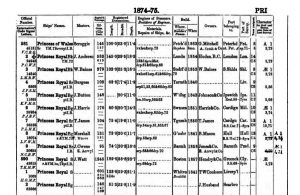For most of us, the uninitiated, Lloyd’s immediately conjures up visions of the vast insurance giant. The other aspect of Lloyd’s is the part known as Lloyd’s Register. Brian has worked for LR which is a well-respected conglomerate derived from the same origins.
It is owned by the Lloyd’s Register Foundation, a UK charity dedicated to research, education and science. In particular, they pride themselves on knowledge, integrity and technical excellence. Their clients are given confidence that their assets and businesses are safe and depend on LR’s compliance and technical know-how.
LR’s turnover is £1.3 billion, and they employ 9,000 staff. It started from the original coffee house concept as Lloyd’s Insurance in 1688. LR was the first, in 1760, to ensure that ships were built and maintained to an appropriate standard for safety and efficiency. John Angerstern, a mechanic and engineer, was appointed the first Chairman of LR, and 16 surveyors – either master mariners or shipwrights – were employed for information and advice. The first register of ships was soon produced, containing information on 4,118 ships from 16 different ports.
Thomas Chapman was appointed the first secretary of LR in 1834, establishing new systems which are still in use today, such as foreign bases around the world which were established with discipline and credibility.
Suirius was an early iron steamship certkified by LR. Lizzie Leslie was the first iron sailing ship classified as ‘100 A1’ in 1870. The 19th century saw the introduction of composite materials for ships such as the Cutty Sark, and A. Cornish was a surveyor between 1900 and 1909 who conducted research for the Cunard Line on the Mauritania and Lusitania.

The Mirex, a tanker for transporting crude oil from the Black Sea to the UK, was registered for Shell Oil in 1892, and the Bakin was the first modern oil tanker.
From 1920, LR began inspection of oil storage tanks, built for use in the Middle East. The inspection of electrical generating plants, particularly boilers, came within LR’s remit .
Also in 1920, Joseph Isherwood oversaw the construction of SS Fullgar, the first all-welded seagoing tanker to be registered 100 A!. The Beldis, built in 1924 by Armstrongs for the Norwegians, was the first heavy-lift ship.
LR were appointed inspectors of the Americas Cup yachts in the 19th century, and they still inspect luxury yachts. In the 1930s they were the inspecting authority for aircraft, although this work was later taken over by the Civil Aviation Authority.
During World War II, LR assisted shipbuilders in reconstructing their merchant fleet after many losses during the conflict They were also involved in the investigation into many marine disasters, such as explosions on bulk carriers, and their scope now also covers the design and inspection of oil rigs.
Our speaker, Brian Smith, continues his involvement today to re-establish merchant navy apprenticeships in Hull. This, hopefully, will re-establish Great Britain’s place in the nautical world. It was an excellent presentation, by a gentleman who knows his business.
